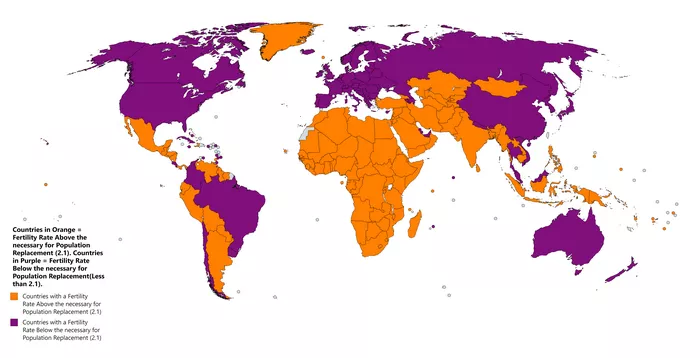Fertility rate stands as a pivotal metric in demographic studies, delineating the average number of children born to women of childbearing age within a specific population. This metric serves as a cornerstone in understanding population dynamics, offering insights into trends shaping societal, economic, and healthcare landscapes. By scrutinizing fertility rates, demographers, policymakers, and healthcare professionals discern patterns of population growth, aging, and distribution.
Global Overview of Fertility Rates:
Across the globe, fertility rates exhibit remarkable diversity, reflecting a myriad of factors influencing family planning decisions. Some nations experience soaring fertility rates, characterized by robust population growth, while others grapple with declining rates, portending demographic shifts and associated challenges. Notable examples include Niger, with one of the highest fertility rates globally, juxtaposed with countries like Japan, where fertility rates plummet to unprecedented lows.
Identifying the Country with the Lowest Fertility Rate:
Among nations grappling with notably low fertility rates, one stands out prominently: Japan. Renowned for its advanced technological landscape and rich cultural heritage, Japan faces a demographic conundrum marked by declining birth rates. Statistics underscore this reality, with Japan consistently ranking among the countries with the lowest fertility rates globally.
Recent data reveals Japan’s fertility rate hovering around 1.36 births per woman, a figure significantly below the replacement rate of 2.1 necessary for population maintenance. This trend, emblematic of broader societal shifts, underscores the multifaceted challenges precipitating low fertility rates.
Factors Influencing Low Fertility Rates:
A plethora of socio-economic, cultural, and environmental factors converge to shape Japan’s fertility landscape. Economic stability, while ostensibly a boon, paradoxically contributes to declining fertility rates as individuals prioritize career advancement over starting families. Limited access to affordable childcare and housing exacerbates this trend, dissuading couples from expanding their families.
Educational attainment emerges as another salient determinant, with higher levels of education inversely correlated with fertility rates. Urbanization further compounds this issue, as urban dwellers contend with space constraints and heightened financial burdens associated with child-rearing. Cultural norms surrounding marriage and parenthood, evolving in tandem with societal changes, also exert a profound influence on fertility decisions.
Impact of Low Fertility Rates:
The repercussions of Japan’s low fertility rates reverberate across multiple spheres, heralding far-reaching implications for society, economy, and healthcare systems. A rapidly aging population strains healthcare resources and pension systems, precipitating a looming demographic crisis. Labor shortages ensue, impeding economic growth and innovation, while exacerbating social welfare burdens.
Government Policies and Initiatives:
In response to the demographic imperative, the Japanese government has implemented an array of policies and initiatives aimed at bolstering fertility rates. These encompass an expansive spectrum, ranging from financial incentives for childbearing couples to initiatives promoting work-life balance and flexible employment arrangements. Subsidized childcare programs and enhanced maternity and paternity leave provisions seek to alleviate the burdens confronting young families.
Cultural and Social Perspectives:
Navigating the intricate interplay between cultural norms and fertility decisions proves imperative in understanding Japan’s demographic landscape. Traditional paradigms emphasizing career advancement and individual pursuits increasingly diverge from traditional notions of family and parenthood. Marriage rates plummet as individuals prioritize personal fulfillment over societal expectations, underscoring the seismic shifts underway in Japan’s socio-cultural fabric.
Comparison with Other Countries:
Drawing parallels with other nations confronting similar fertility trends offers valuable insights into shared challenges and divergent approaches. Countries across East Asia, such as South Korea and Taiwan, grapple with analogous demographic predicaments, navigating comparable socio-economic and cultural landscapes. Contrasting policies and initiatives shed light on the nuanced interplay between governmental interventions and societal dynamics in shaping fertility trajectories.
Future Outlook and Challenges:
Charting the trajectory of Japan’s fertility rates engenders cautious optimism tempered by lingering challenges. Projections suggest a continued decline in fertility rates, exacerbating demographic imbalances and attendant socio-economic strains. Addressing these challenges necessitates a multifaceted approach, encompassing policy reforms, cultural shifts, and targeted interventions aimed at fostering a conducive environment for family formation.
Conclusion:
In traversing the intricate terrain of fertility rates, Japan emerges as a poignant exemplar of demographic dynamics in the modern era. Anchored by an amalgam of socio-economic, cultural, and environmental factors, Japan’s low fertility rates illuminate the confluence of challenges confronting contemporary societies. As Japan and nations worldwide grapple with the imperative of sustaining population growth, understanding and addressing fertility rate trends assume paramount significance for fostering sustainable development and societal well-being.
Related Topics:
The Impact of Alcohol on Male Fertility: A Complete Overview



























